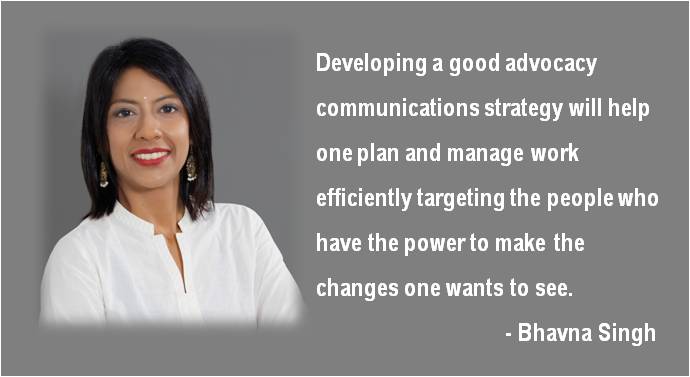“The ability to communicate is essential to the success of any undertaking and an important factor in the achievement of its objectives. We have entered an age of knowledge, and the key to accessing and harnessing that knowledge lies in the ability to communicate.” 1
Advocacy is all about influencing and driving change. And this will happen only through effective, consistent and focused communication. A strategic and creative advocacy communication campaign is proactive rather than reactive to the external factors; thereby driving the agenda, ahead. In the social and economic development context the aims of advocacy are to create or change policies, laws, regulations, distribution of resources or other decisions that affect people’s lives and to ensure that such decisions lead to implementation.
Developing a good advocacy communications strategy will help one plan and manage work efficiently targeting the people who have the power to make the changes one wants to see. It not only increases awareness of the issue; it allows for consistent communication within the organisation.
Of course, similar to a PR campaign, it is important to follow the must-haves in an advocacy communication campaign. Here are some tips to build into the campaign:
- Well- defined goals: The goals need to clear and measurable. They need to be doable and not ambiguous. If the goal is to provide clean sanitation; then mass-awareness on sanitation and the linkage between sanitation and hygiene needs to be established clearly. The long-term communication goal however will be to raise the issue of hygiene in the political agenda.
- Mapped target audience: Who are they? What is their thinking? What are their key values that drive them to do something? These questions need to be answered.
- Articulated messages: The messages need to be simple. Messages are designed to achieve goals. A successful advocacy campaign will most certainly involve simple messages that resonate with stakeholders and garner support to the campaign. This does not mean restating the goals. It simply means building a compelling case with your target audience.
- Structured Planning and Research: In addition to the above; planning both in terms of time and money is critical. Think strategy before moving to tactics. Jon Haber of Fleishman-Hillard says “the laziest thing people do is go right to tactics.” A press briefing is a tactic. You have to start with what you are trying to get done, who can do it, what you communicate with them and who has to persuade them to speak. Research is the basis of the communication. Getting the right advocates is the key.
- Designated roles for stakeholders: Designing roles for stakeholders is important. In our minds, it is necessary to essay the part of each stakeholder and their contribution to the entire advocacy communication piece. The roles also bring clarity to the engagements and discussions to be held with each stakeholder. Taking the example of the sanitation campaign- the dialogues with policy makers will be starkly different from the dialogues to be held with the ‘public.’
- Carefully designed toolkit: Implementation holds the key. The implementation needs to be broken down to the various levels and should cover the communication approaches to be taken for each stakeholder at individual levels. Effective campaigns are built on decision points, real or created. Maybe legislation is possible now or an international/global platform is addressing the same issue soon or some event being organised, has made the issue timely and current. Tell people why now.
The success of any advocacy communication campaign is also simple. Advocacy communication to bring about policy changes takes time and patience. Like consumers, politicians and policy makers are influenced by the power of repetition. The many number of times an issue is repeated and echoed is critical. Hence, marrying strategy and tactics will help in driving an effective advocacy campaign. To summarise, developing a good advocacy communication strategy will help one plan and utilise time and money effectively. What it does is to provide clarity on issues; goals and deliverables for a sustained advocacy, driving change.
1 The RM Knowledge Translation Toolkit: A Resource for Researchers, Research Matters Programme, IDRC, http://www.idrc.ca/uploads/user-S/1226604865112265957811Chapter_6%5B1%5D.pdf see also www.research-matters.net







Excellent insights. I think this is a new-age communication aspect which has been nicely articulated by Bhavna. It’s a good read and an excellent tool for any communication professional to implement. Look forward to more such articles.
Liked Bhavna’s article above. Very well thought through and helpful.
Well written.. concise and has all the key points.